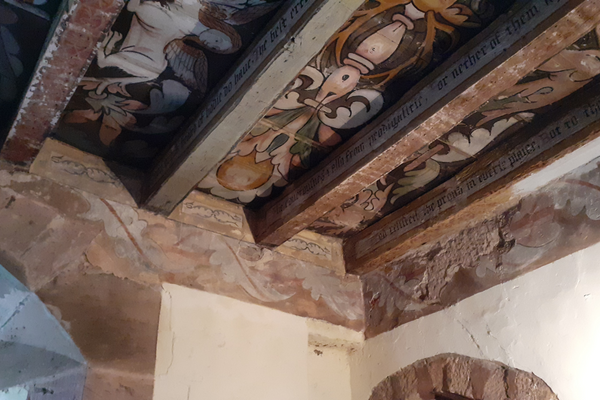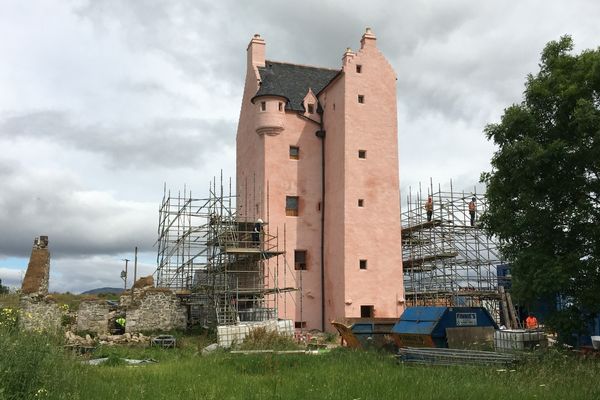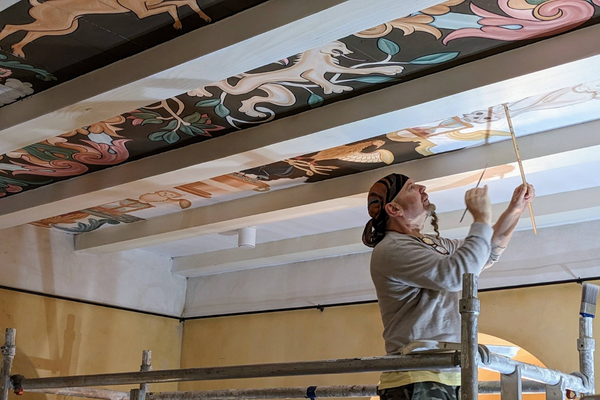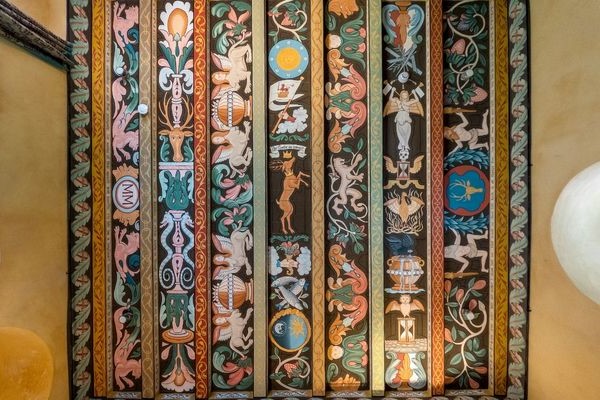The 'perfect project'
The proposal for a painted ceiling in Fairburn Tower was to provide a 'bright and appealing interior' as well as being a 'historically accurate evocation' and the painted ceiling in Delgatie Castle was to be our 'reference'. I have carried out decorative restoration and conservation in many of Scotland’s Castles from the mid-1980s, with early painted ceilings styles and colour palettes being a constant source of fascination for me. After learning of the proposal for Fairburn Tower, I thought ‘this sounds like the perfect project, I hope all goes ahead as described’.
Visiting Delgatie Castle
Dates were allocated for me to visit Fairburn Tower and Delgatie Castle in the last few days of February 2022. Delgatie Castle was the first stop. I wanted to spend a generous amount of time here studying the ceiling, as I needed to study the original artist’s style. Although the Delgatie ceiling had been restored, the black outlines that define the forms, emblems and heraldic content survive in reasonable condition, or else had been quite faithfully traced by the restorers.
 Detail of the ceiling in the Rohaise Room at Delgatie Castle.
Detail of the ceiling in the Rohaise Room at Delgatie Castle.
Scholars generally agree that this outlining was performed by the artist and the blocking in of colour would likely be the work of the artist assistants. It is from these outlines that I can really study the movements of the original artist’s hand, what the artist liked to do, even what the artist avoided doing. For me this study helps me see what will come naturally when painting the ceiling, and what will need to be conscientiously focused on and imitated. As well as the distinctive draughtsmanship, the Delgatie ceiling displays a stunning array of earth pigments. For me, it was an entirely natural process to relay these colours for the ceiling at Fairburn, as I could clearly identify the ochres, umbers, green earths and siennas that are part of that wonderful gentle earth palette we see at Dalgatie.
The next stage was a full photographic survey of the Delgatie ceiling, inch by inch. After the photography, I started taking notes on a large colour chart to help me accurately reference the colours and tone strengths for our ceiling at Fairburn. Of course, the ceiling at Fairburn was specified to look as it may have done back in 1595, so the colours would be strong and fresh without the environmental aging historic ceilings endure from fire smoke and candles.
The first of many visits to Fairburn Tower
The next stop the following day was Fairburn Tower to meet Landmark’s Senior Surveyor, Linda Lockett for an on site tour. Taking the tour was ideal as the supplied photographs could only manage to communicate so much. I was impressed with the efforts by the team in all aspects of Fairburn as we explored the tower. We finally moved to view what would come to be my 'blank canvas', the 'sitting room' ceiling, around 5 metres square and not too high to reach on scaffolding.
 Fairburn Tower under restoration.
Fairburn Tower under restoration.
From paper to ceiling
Back in my studio, the design stage came next. A central part of my practice is to show the client a visual of how their completed project will look. For Landmark, this was done by a series of digital designs and mock ups, including 3D visualisations of the room, faithful to scale, designs, materials and colours. I feel the design guidance received at this stage from Landmark’s historian, Caroline Stanford and Director, Anna Keay gave the ceiling design a real fusion of its parts, a unity and awareness that communicates at an optimum level. Once the designs were given the green light, my next task was to draw out the whole ceiling in full scale on a large continuous roll of paper in my studio. My full-scale drawings were first made in pencil, then studied for accuracy and style and finally inked in. The ink line bleeds through to the back of the paper, and this provides a guideline on the reverse side that I follow with a stick of willow charcoal.
Back at Fairburn again, I carefully applied the drawing up in place on the ceiling and then followed my ink guidelines with a fine agate tipped burnisher. This transfers a faint charcoal line directly from the paper onto the gesso surface of the ceiling (gesso is a mixture of paint and binder to provide a smooth surface). I evolved this transfer technique from an elderly lady who worked with the Wemyss School of Needlework in Fife. She showed me the laborious process of taking a pin and repeatedly piercing the lines of the pattern drawing on paper, then laying it over the material and using a pounce bag full of charcoal dust to transfer the design drawing to material. This is a very old technique and traces of its use have been found on early 17th century painted ceilings in Scotland.
To take the transfer a stage further, I used a pricking wheel to set out the lines on the paper, as well as the agate burnisher. The burnisher was one of my trade secrets, but since Channel 4 have filmed me using it, it may become broader knowledge now! With most of the charcoal lines transferred up in place, the next stage was to mix my paints to match a fresh 1595 version of the Delgatie palette. The mixes were made up in labelled glass jars, and I kept a colour chart in my Fairburn notebook along with notes on the colour compositions, all vital in case more paint of the same colour had to be made to complete the ceiling.
 Working on the painted ceiling at Fairburn Tower.
Working on the painted ceiling at Fairburn Tower.
For the Fairburn ceiling I used 'Lefranc Bourgeois Flashe' paint. Lefranc was founded in 1720. 'Bourgeois Flashe' was developed in the 1950s and is well established for use in historic restoration projects. Importantly, it offers the completely matt finish inherent to the casein and glue tempera paint the historic Scottish ceilings were generally painted in. With the technical approach done and dusted, what lay ahead was to try and maintain a high level of concentration in the execution of the painting to get it right. Keeping in check the paint applied, I made what must have been hundreds of visits to my tablet to zoom in on my Delgatie photography to never lose a grasp of the nature of the historic inspiration for Fairburn.
Reflecting on the project
I would like to think as an artist who studies these ceilings and deploys my knowledge conscientiously that I can take on most layout scenarios when recreating for a client. Yet as I walk round beneath the completed ceiling at Fairburn today, I can’t help feeling that having Landmark’s additional input has taken the ceiling a stage further, both for the viewer today, and for posterity.
My time at Fairburn has left me with many memories that will endure. The surrounding drama of the landscape in changing light, along with a rich variety of wildlife. The feeling of peace on those pitch black nights when I would work late, alone, with classical or atmospheric music playing on my sound system. Going outside late at night and looking back at Fairburn Tower with the interior lights on and witnessing that giant leap from it being a building site, to feeling like a home - all details to take stock of and commit to that file in the mind marked 'best times'.
 The finished painted ceiling.
The finished painted ceiling.
Paul Mowbray 2022